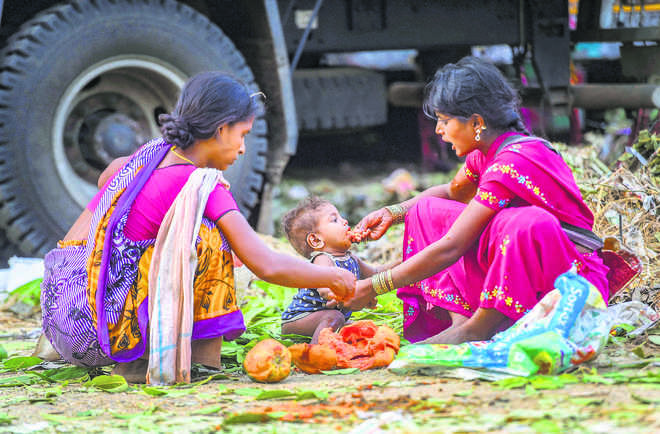
Hunger pangs: Over 2,400 children are succumbing to under-nutrition every day. It shows how poor diets are responsible for the tragedy.
Devinder Sharma
Food & Agriculture specialist
This strange paradox of plenty remains unexplained. At a time when grain silos are bursting at the seams, the 2019 Global Hunger Index (GHI) has ranked India 102nd among 117 countries, placing it in a category with ‘serious’ levels of hunger. As if this is not enough, the latest UNICEF report on the State of World’s Children lists India with the highest burden of death among children below five years, accounting for 8.82 lakh children dying last year.
While the Ministry of Consumer Affairs, Food and Public Distribution has reportedly written to the Ministry of Foreign Affairs to help reduce the burden of carrying overflowing food stocks with the FCI by looking into the possibility of providing surplus food as ‘humanitarian aid’ to deserving countries, ironically 90 per cent children in the age bracket of six to 23 months do not get enough to eat. While acute hunger stalks the impoverished, a silent tragedy affecting our most precious resource — children — has been quietly unfolding. Every second child is stunted, wasted or underweight.
Reports say that against the requirement of buffer stocking norms of 307.70 lakh tonnes of foodgrains required on October 1, the FCI was already saddled with over double the quantity — 669.15 lakh tonnes of wheat and rice — a month earlier, on September 1. With paddy harvest now in full swing, food stocks in the Central pool can be easily expected to further swell in the weeks to come. Add to it the bumper harvest of fruits and vegetables at 314 million tonnes in 2018-19; and a record milk production of 176 million tonnes, there appears to be no shortage of available nutritious food. With abundant food supplies, there is no reason why India should be harbouring the largest population of hungry in the world. As someone had said, if every bag of surplus foodgrain was to be stacked one over the other, it will be possible to walk to the moon and come back. The surplus stock has in fact grown ever since.
Despite the huge food surplus, India’s hunger ranking is in fact much worse than the neighbouring countries. While China records an impressive standing at 25th position, India lags behind all BRICS countries and its performance leaves much to be desired when compared with Sri Lanka (66), Nepal (73), Bangladesh (88) and Pakistan (94). Even Venezuela (65), North Korea (92) and Ethiopia (93) perform much better. Ever since the GHI report was first released in 2006, and 14 reports later, nothing seems to have changed in India.
It is all a question of priorities. While the emphasis has remained on achieving a higher growth trajectory, hunger and malnutrition has been simply brushed under the glare and glitter of economic growth. But hunger continued to defy the predominant economic prescription which believes that a higher economic growth will help reduce the population living in hunger. On the contrary, as economic growth grew, so did hunger and malnutrition. And this, despite former PM Manmohan Singh calling malnutrition ‘a national shame’. Earlier too, successive PMs had vowed to fight hunger but somehow hunger and malnutrition remained robustly sustainable.
While removing hunger is a complex task, and quite a lot has been achieved in addressing child malnutrition, the monumental task to make hunger history is not impossible. Besides the enactment of the National Food Security Act (NFSA) 2013, which provides subsidised grains to two-third of the population, and a number of programmes to fight malnutrition, eradicating hunger and malnutrition does not seem to be a stated objective of the macro-economic policies. Even when the NFSA was being deliberated, mainline economists had voiced concern that any move to enhance food subsidy would increase fiscal deficit.
This is in contrast to a programme initiated by a former Brazilian President, Lula da Silva, in 2003, to eradicate extreme poverty and hunger. The ‘Zero Hunger’ programme dovetailed a mixture of emergency aid with structural reforms in agriculture. According to The Guardian, nearly 32 million people (16 per cent of the population) were pulled out of poverty by 2011 through a programme which relied on ‘income transfer programmes such as Bolsa Familia — which supported over a quarter of the population — combine food safety, access to education and health, and measures to foster local development, especially in rural areas.’ Brazil is now ranked 18, even higher than China, in the GHI index.
Brazil’s ‘Zero Hunger’ programme had successfully linked food production with hunger eradication. There might be gaps, but still it offers a time-bound framework that can be replicated. In India, while the policy emphasis remains on increasing food production, and the surplus is diverted to meet the food requirement in deficit areas, farmers’ welfare appears to be nowhere high on priority. With 600 million work force engaged in agriculture, directly and indirectly, a revival of agriculture is fundamental. This has to be accompanied by enhancing public sector investments, which according to the RBI had remained at 0.4 per cent of the GDP between 2011-12 and 2016-17.
A lot of promises to fight hunger have been half-heartedly made over the past few decades. But the fact that an alarmingly high number of casualties — over 2,400 children — are succumbing to under-nutrition every day, categorised as ‘burden of death’, shows how poor diets are responsible for the tragedy. With no shortfall in food production, and with ability to rejig economic policies, all it requires is a strong political will to remove hunger. India cannot dream of being an economic superpower with a large population of hungry and malnourished.



























